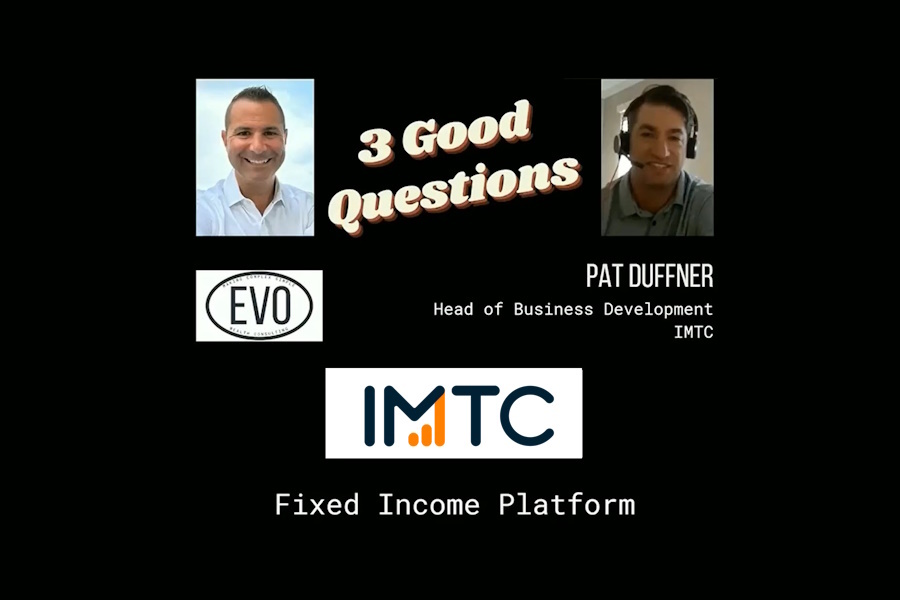Takeaways from the 2018 Fixed Income Leaders Summit

Earlier this month, we were invited to attend the European Fixed Income Leaders Summit in Amsterdam. I had the opportunity to pitch our portfolio optimization solution to a panel of industry experts and VC investors during the Dragon’s Den competition – for you Shark Tank fans out there, it felt like I was up in front of Mr. Wonderful.
While we unfortunately did not win the competition, it was still an extremely productive 3 days of programming. I was able to meet with executives, PMs and traders from a remarkable group of European asset managers to discuss their latest thinking on business priorities, technology pain points and the future of the fixed income markets.
Below are a few recurring themes that came up through the course of conversations and presentations during the event.
1. Trading Desks are Going Electronic
Institutional money managers are feeling the squeeze. Rising costs coupled with a challenging operating environment have led to tighter margins and strained capacity. Executives acknowledged the need for scalable solutions to optimize cross-functional processes. I heard a few interesting propositions among different stakeholders.
Automation is the obvious answer to capacity issues. This can mean different things to different people. For instance, many trading units are in the process of deploying automated technology to handle the execution of liquid instruments – so long as they are in block sizes that will not have an adverse impact on the market. Vanilla interest rate swaps and CDS are two types of instruments that lend themselves to automated trading, especially during the roll period. In the near-term, odd-lot trades are also expected to become fully automated as technology and the use of algorithms enable mechanized solutions.
The role of the trader will not be eliminated, merely optimized. Rather than picking up the phone to execute a buy or sell order, traders of the future will be managing algorithms – ensuring the code is functioning appropriately and making adjustments to accommodate the more human elements of the market.
2. Data Management is a Strategic Priority
90% of the world’s data has been created in the last two years – and the volume of data being generated is only picking up speed. However, the majority of this data is not structured, let alone standardized. Utilizing data effectively to inform your investment process can make the difference between top and bottom quartile returns.
We at IMTC (formerly CBXmarket), along with a host of other FILS attendees, believe the industry needs to come together to establish a set of reporting standards that can be adopted across the marketplace. Unlike in the U.S. where investors can rely on TRACE for reliable trade information, there is no consolidated tape of trades published across European fixed income markets. In order to reduce the opacity of markets in Europe and other parts of the globe, there needs to be an emphasis on standardized reporting. This will alleviate substantial pressure on back- and middle-offices and further enable efficiencies of automation technology.
3. Regulation is Driving Technology Investments
The ever-changing regulatory environment across jurisdictions has been a catalyst for firms to invest heavily in technology. MiFID II and AIFMD, among other regulations, have created new operational burdens that firms must accommodate. Technology poses a viable solution to efficiently maintain reporting requirements without adding headcount. However, these new regulations are not just contributing to a reporting burden but are also requiring the sell-side to adjust their business models, particularly for trading and research units.
The discussions from the conference made it clear that we, as an industry, cannot afford to fear technology. Fixed income desks have no choice but to innovate to stay competitive, and embracing the digital age can only help facilitate that transformation.
4. The Jury Is Out on Regulatory Reform of Primary Markets
While regulation in fixed income markets has intensified in recent years, a big question mark still remains regarding regulatory reform in the primary markets. Buy-side shops expressed much discontent around unfair practices for new issue allocations. The lack of transparency creates less than democratic distribution of primary issuances.
This controversy is by no means new. While asset managers have continued to voice concerns, there is no consensus around the best path toward solving allocation problems. Many believe regulatory intervention is the only way to mandate incremental transparency. Other stakeholders are advocating for sell-side firms to drive a ‘self-regulatory’ solution.
All the while buy-side investors have struggled to develop standardized workflows to support book-building and portfolio allocation functions without a heavy lift — collecting the necessary data from book runners. Ultimately, without consensus, the labor-intensive dealing processes are likely to continue in lieu of a more efficient technology-driven operating environment.
5. Active Managers are Finding New Ways to Compete
Active managers are coming up with creative means of combating the shift to passive investment vehicles. The historical approach to active management was labor intensive – and frankly, unscalable. As money continues to flood into passively managed funds, active managers are deploying technology to deliver alpha in unique ways within their client portfolios. Monitoring, reporting and rebalancing exercises, previously manual processes, can now be delegated to software solutions – freeing up capacity for PMs and analysts to proactively focus on alpha-generation in this low yield environment.
Proper utilization of technology can enable active managers to differentiate themselves by providing clients with both flexibility and client-centric solutions that passive investment funds cannot accommodate. As the institutional investment community shifts its tastes toward more bespoke solutions, active managers are in a position to regain market share.
In closing, it was abundantly clear that technology was top-of-mind for all conference participants. The question is no longer if there is a technology-driven solution for a given problem, so much as which type of technology poses the best solution. We are pleased to know that we were not alone in acknowledging the need for workflow automation, algorithmic monitoring and decision-enhancement tools, and more efficient communication and idea-sharing solutions.
It appears that technology transformations for firms across the asset management industry will continue to pick up steam rolling into 2019. We believe we are well-positioned to support these firms as they move forward into the digital age of asset management.
Until next time,
Russell





